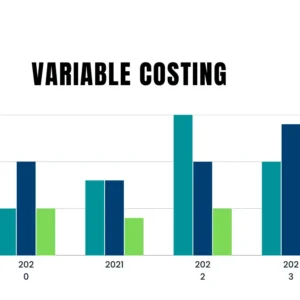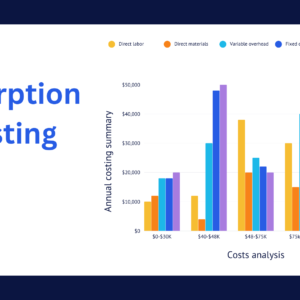What is job costing?
It is a method of tracking the costs of a specific job or project to determine its total cost and profitability. It involves identifying and accumulating the costs associated with a particular job, such as materials, labor, and overhead expenses, and then allocating those costs to the job based on an agreed-upon cost driver, such as labor hours or machine usage. Job costing is one of the important components of manufacturing accounting.
This information can be used to calculate the total cost of the job and to determine whether it was profitable or not. Job costing is commonly used in industries such as construction, manufacturing, and professional services, where each job or project is unique and requires its own set of resources and expenses.
Importance
- Accurate Cost Determination: It helps in accurately determining the cost of each job or project. By tracking and allocating costs specific to each job, businesses can have a clear understanding of how much resources, such as materials and labor, are being consumed for that particular project. This information is essential for pricing the job appropriately and ensuring profitability.
- Profitability Analysis: It enables businesses to analyze the profitability of individual jobs or projects. By comparing the total cost of a job with the revenue generated from it, companies can assess whether a particular project is financially viable or not. This helps in identifying profitable areas of business and making informed decisions regarding future project selection.
- Cost Control and Budgeting: It provides a mechanism for monitoring and controlling costs. By tracking expenses at a granular level, businesses can identify cost overruns or inefficiencies early on and take corrective actions. This information is valuable for budgeting purposes as it allows for better forecasting of costs and helps in establishing realistic budgets for future jobs.
- Performance Evaluation: It facilitates performance evaluation on both individual jobs and overall business levels. By comparing the estimated costs with the actual costs incurred, companies can assess the accuracy of their cost estimation process and identify areas for improvement. It also helps in evaluating the performance of project managers or teams based on their ability to complete jobs within budgeted costs.
- Decision Making: It provides valuable insight for decision-making. It helps businesses in evaluating the financial impact of accepting or declining certain projects. By considering the estimated costs and potential revenues associated with a job, companies can make informed decisions regarding resource allocation, pricing strategies, and overall business strategy.
Job costing vs process costing
Job costing and process costing are two methods used to determine the cost of products or services. Job costing is used for customized or individual projects, tracking costs specific to each job. Process costing is used for continuous or repetitive production, allocating costs to production processes or departments.
| Aspect | Job Costing | Process Costing |
| Nature of Production | Customized or individual jobs/projects | Continuous or repetitive production |
| Cost Accumulation | Costs are accumulated by job or project | Costs are accumulated by production process/department |
| Cost Allocation | Costs are allocated to each job based on actual resources | Costs are allocated to units based on average cost per unit |
| Product Variability | Each job or project is unique | Products follow a standardized production process |
| Unit Cost Calculation | Unit cost calculation is based on individual jobs | Unit cost calculation is based on average cost per unit |
| Examples | Construction, consulting, custom manufacturing | Food processing, chemical manufacturing, assembly-line production |
Applications
Construction Industry:
It is widely used in the construction industry. Each construction project is unique and requires careful tracking of costs related to materials, labor, equipment, subcontractors, and other expenses. Job costing helps construction companies accurately determine the costs associated with each project, evaluate profitability, and make informed decisions regarding pricing and resource allocation.
Consulting and Professional Services:
It is vital in consulting firms and professional service providers such as accounting, legal, or engineering firms. These businesses often work on client-specific projects or engagements. Job costing allows them to track and allocate costs specific to each client or project, ensuring accurate billing, evaluating project profitability, and optimizing resource utilization.
Manufacturing and Custom Production:
Industries involved in manufacturing customized or made-to-order products benefit from job costing. Whether it’s producing custom furniture, machinery, or specialized components, job costing enables businesses to track material costs, labor hours, and overhead expenses associated with each custom order.
Film and Entertainment Industry:
Job costing is crucial in the film and entertainment industry, where each production is a unique project. Film studios, production companies, and event management companies use job costing to track and allocate costs related to cast and crew salaries, equipment rentals, set construction, special effects, location expenses, and other production-related costs.
Software Development and IT Services:
Job costing is applicable in the software development and IT services sector, where projects are often tailored to meet specific client requirements. IT companies use job costing to track costs associated with software development, system integration, consulting projects, and managed services.
These are just a few examples of industries where job costing is commonly applied. Any business that engages in customized or project-based work can benefit from implementing job costing practices to better understand costs, evaluate profitability, and make informed business decisions.
Practical example
| Job Cost Sheet | ||
| Job Number: J123456 | ||
| Job Name: Project ABC | ||
| Date: May 12, 2020 |
| Direct Materials | Quantity | Unit Cost ($) | Total Cost ($) |
| Material A | 50 | $10.00 | $500.00 |
| Material B | 100 | $5.00 | $500.00 |
| Material C | 20 | $15.00 | $300.00 |
| Total: | $1,300.00 |
| Direct Labor | Hours | Labor Rate ($) | Total Cost ($) |
| Labor A | 20 | $25.00 | $500.00 |
| Labor B | 15 | $20.00 | $300.00 |
| Total: | $800.00 |
| Direct Expenses | Amount ($) |
| Subcontractor Costs | $1,000.00 |
| Equipment Rental | $500.00 |
| Total: | $1,500.00 |
| Indirect Costs | Amount ($) |
| Overhead Allocation | $2,000.00 |
| Total: | $2,000.00 |
Direct costs = Materials + Labor + Direct expenses
Indirect costs = Overhead
| Summary | Amount ($) |
| Direct Costs | $3,600.00 |
| Indirect Costs | $2,000.00 |
| Total Job Cost: | $5,600.00 |
Cosn of job costing
- Time and Resources: Setting up and maintaining a job costing system requires an investment of time and resources. It involves developing appropriate cost-tracking procedures, establishing cost codes or categories, and training employees on how to accurately record and allocate costs to specific jobs.
- Software and Technology: Depending on the complexity and scale of your business, you may need to invest in job-costing software or tools to streamline the process. This can involve upfront costs for purchasing or licensing the software, as well as training employees on its use. However, there are also free or low-cost options available that can meet the needs of small businesses.
- Data Accuracy and Integrity: Job costing relies on accurate and reliable data. Businesses must ensure that the data entered into the job cost sheets is correct and complete. This may require implementing internal controls and procedures to validate data and prevent errors or inaccuracies. Data integrity is crucial for obtaining meaningful insights and making informed decisions based on job cost information.
- Overhead Allocation Challenges: Allocating indirect or overhead costs to specific jobs can be challenging. It often involves using predetermined cost drivers or allocation methods. Determining the most appropriate allocation basis and ensuring consistency and accuracy in the allocation process can be complex, especially in businesses with diverse operations or shared resources.
- Continuous Monitoring and Analysis: Job costing requires continuous monitoring and analysis of job costs to derive meaningful insights. This involves reviewing cost reports, comparing actual costs against estimated costs, and evaluating job profitability. The time and effort spent on analyzing job costs should be justified by the benefits gained in terms of better cost control and decision-making.





[…] Job costing is a costing method used by manufacturers to track and allocate costs to specific jobs or projects. It is particularly useful in industries where each product or project is unique and requires a distinct set of resources. With job costing, costs are directly attributed to individual jobs, allowing manufacturers to accurately determine the total cost associated with each job. […]
[…] Job order costing provides accurate cost information for each job, enabling businesses to determine the profitability of individual projects, assess customer pricing, and make informed decisions about resource allocation. It is commonly used in industries such as construction, manufacturing, printing, and custom manufacturing where products or services are tailored to meet specific customer specifications. […]
[…] Job Order Costing is a costing method used to allocate costs to individual units or batches of products, often employed in industries where goods or services are produced based on specific customer orders. For example, a custom furniture manufacturer implementing job order costing would track the direct materials, labor, and overhead costs associated with each unique furniture piece commissioned by a customer. […]